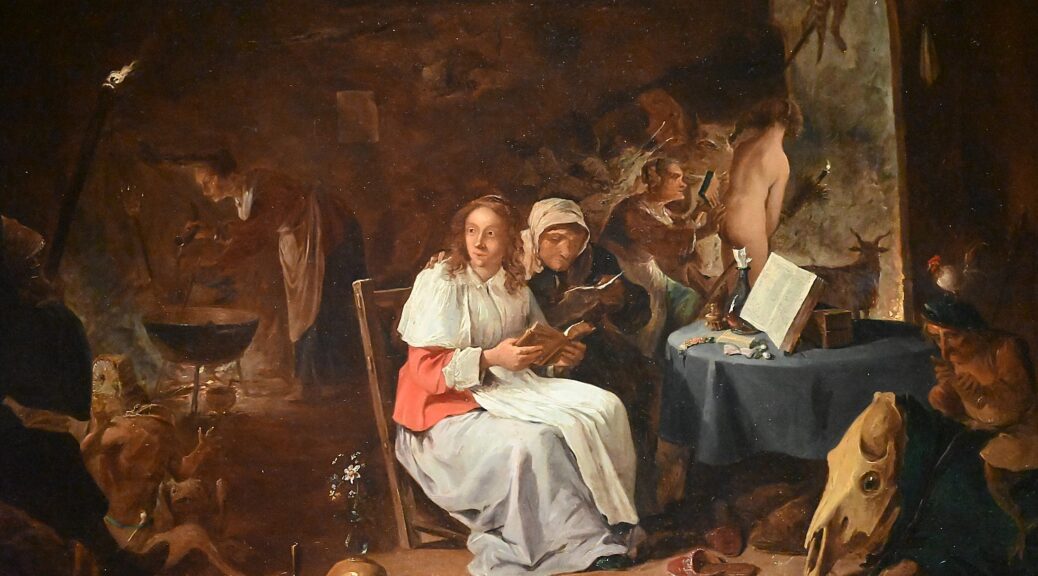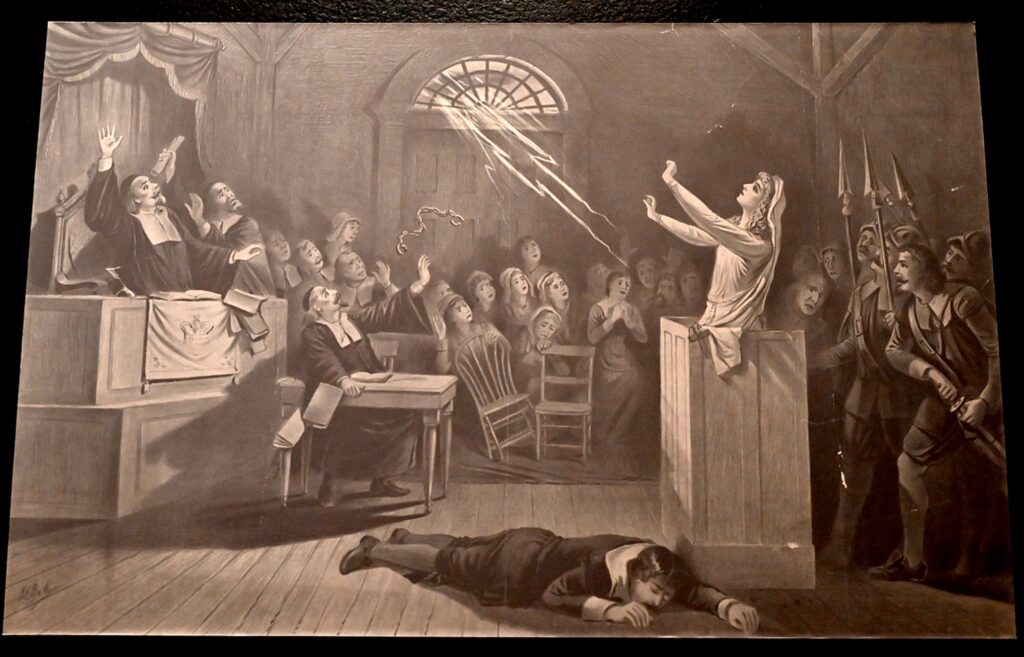
By Karen Rubin, Travel Features Syndicate, goingplacesfarandnear.com
In an episode that has resonated through American culture from colonial times until today, more than 200 residents of Salem, Massachusetts, were accused of witchcraft in 1692-93. The trials led to the executions of 19 people, most of them women, and the deaths of at least six more. The last of the accused, Elizabeth Johnson Jr., was only officially exonerated this past summer.
In a new exhibit, “The Salem Witch Trials: Reckoning and Reclaiming,” the New-York Historical Society reexamines this defining moment in American history and considers from a contemporary viewpoint how mass panic can lead to fatal injustice. On view through January 22, 2023 in the Joyce B. Cowin Women’s History Gallery, this is the final stop of this traveling exhibition, organized by the Peabody Essex Museum (PEM) in Salem, Massachusetts, and coordinated at New-York Historical by its Center for Women’s History, which unearths the lives and legacies of women who have shaped and continue to shape the American experience.

“Countless scholars and authors from Nathaniel Hawthorne to Arthur Miller have kept alive the memory and meanings of the Salem witch trials—but this critical turning point in American history has never before been seen as it is in “’The Salem Witch Trials: Reckoning and Reclaiming’,” said Dr. Louise Mirrer, president and CEO of New-York Historical Society. “We are proud to present this extraordinary exhibition through our Center for Women’s History, exemplifying the Center’s mission to rethink familiar chapters of the past and deepen our understanding of them. We hope our visitors will come away with a new perspective on these terrible events from more than 300 years ago and what they still mean for us now.”
Most spectacularly, the exhibit features actual artifacts and personal items from people involved in the Salem Witch Trials – the accused and the accusers – putting into context how personal, more than political, these accusations were, but how easy it was to prey upon the superstition and stereotypes of women.
The exhibit also features two contemporary artists – the acclaimed fashion designer Alexander McQueen and portrait photographer Frances F. Denny, both of whom are descendents of women who were put to death; Denny even has discovered an ancestor on the other branch of her family who was a central judge in the Salem Witch Trials. Both were drawn to their projects as a tribute to their ancestors and to redress the injustice.
The exhibition opens with historical artifacts, rare documents, and contemporaneous accounts, which include testimony about dreams, ghosts, and visions. Handwritten letters and petitions of innocence from the accused convey the human toll. Contextual materials such as furniture and other everyday items help to situate the Salem witch trials within the European tradition of witch hunts, which date back to the 14th century, while suggesting the crucial ways this episode diverged. Rare documents from New-York Historical’s collection, including one of the first written accounts of the trial from 1693, are also on view.
The artifacts and documents that are exhibited that were owned by people involved in the trials are windows into life at that time.
“What we hope people take away, what happened and why, that real people were involved, ensnared in the tragedy, and spark personal reflections of what you might do when confronted with such injustice,” Dan Lipcan, Peabody Essex Museum’s Ann C. Pingree Director of the Phillips Library, said at a press preview of the exhibit. “We want people to think about what we can do to create a more tolerant, compassionate society so that this doesn’t happen again.”
The exhibit feels so much more relevant and urgent in light of what is happening in Texas with SB8 which incentivizes vigilantes to hunt down women and girls for seeking reproductive health care, and anyone who might aid them; and when you see how Florida is requiring girl athletes to provide menstrual data. Quite literal persecution and terrorism.
“Witches were thought to make a pact with Satan, gaining the ability to unleash maleficia – harmful magic – causing sickness, misery and death. Accusations were overwhelmingly hurled at women, particularly those who were poor or older. Trials engaged the entire community as a form of popular entertainment and social control over women’s behavior, fertility, or knowledge.”
The exhibit begins by putting the Salem witch trials in context of the European witch hunts.
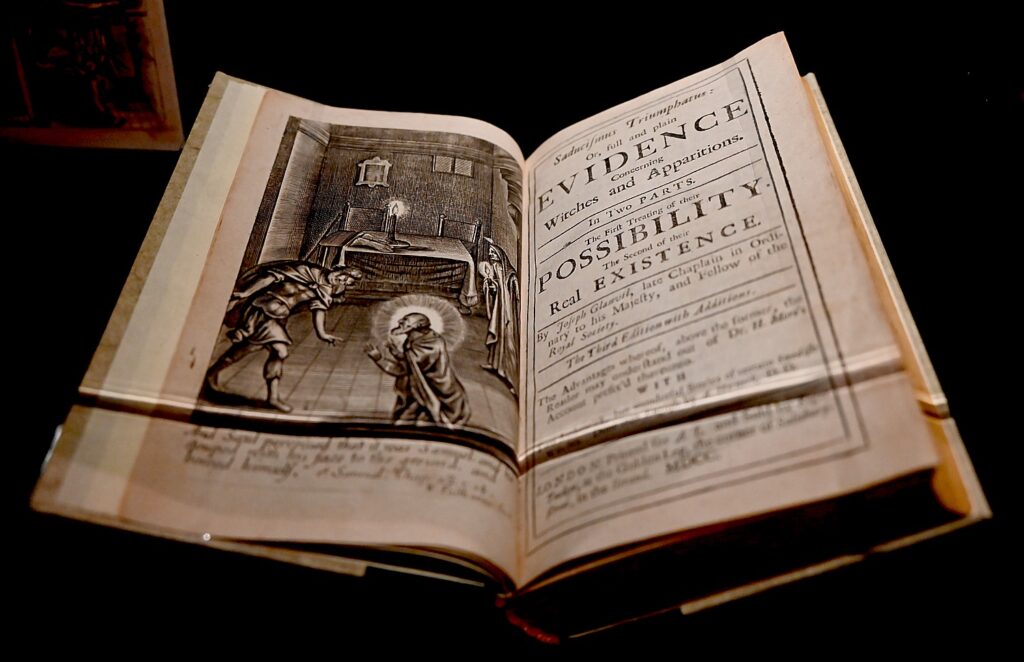
On view is a “best-selling treatise’ from the 1480s Europe on “how to find, identify, prosecute, torture and condemn women for witchcraft.”
Also on view is “Saducismus Triumphatus,” a book from 1700 with intricate woodcuts, in which Joseph Glanvill provides point-by-point rebuttal to any potential skepticism about the existence of witchcraft.
From 1450-1750, in Europe, witch hunts were rampant, some 110,000 trials held and an estimated 50,000 people – 80 percent of them women, were executed (https://www.gendercide.org/case_witchhunts.html). Imagine the daily terror that would have kept women very much in their place, unwilling to speak out with a remedy for sickness or to prevent a woman from dying in childbirth, for fear of being accused of witchcraft or making a pact with the devil.

Witch trials made their way into fiction and art, like a mid-1600s painting we see from Flanders, creating the stereotype of witches as women, regularly accompanied by demons, dwarfs, skeletons and boiling pots.
There were other witch hunts in colonial America, but Salem’s witch trials were more lethal and extreme. They also differed in how they featured spectral evidence- testimony from dreams, ghosts and visions – as legal proof. The afflicted were almost all female and initially were children, rather than men. Accusations started with ostracized women but quickly spread to include elite and powerful community members.
Salem’s witch hunts began with Tatuba, an enslaved woman in the Parris household. Tatuba came from Barbados where enslaved women would work over cauldrons to feed their family and heat their home. Girls accused her of making them unwell. Tatuba (likely beaten) confessed to survive.
“She testified that she had practiced magic under the direction of the other two women initially accused, Sarah Good and Sarah Osborn, who, like Tituba, were disempowered in the community and easily scapegoated. Tituba also claimed that there were more witches at work in Salem. Her confession, combining puritanical, African and Caribbean lore, included signing the devil’s book, using animal familiars to hurt the girls, and riding a pole through the air. It ignited and legitimized the ever-growing hunt for those responsible for the girls’ and the community’s unexplainable hardships.”
By confessing, Tituba outlived the trials which ended 1693, after the court would no longer use spectral (“invisible”) evidence. Her trial was declared “ignoramus” (“We do not know”-that is, there was not enough evidence of her guilt).

One of the objects on view is an actual portion of a window from the Towne family home from 1692: three sisters who were of grandmother-age at the time, were accused; two were hanged, one survived.
“Such surviving objects are very rare – they are precious, fragile,” Paula Richter, the Peabody curator, said at the press preview. “This 17th century window came from a Towne descendent. A window was a luminal space – the space between outside/inside, look in/out, hear in/outside – site of fear. This type of ‘spectral’ evidence was admitted into court and accepted as fact. A window was considered a portal where spectral (bad, unreal) could enter the home and bewitch inhabitants.”
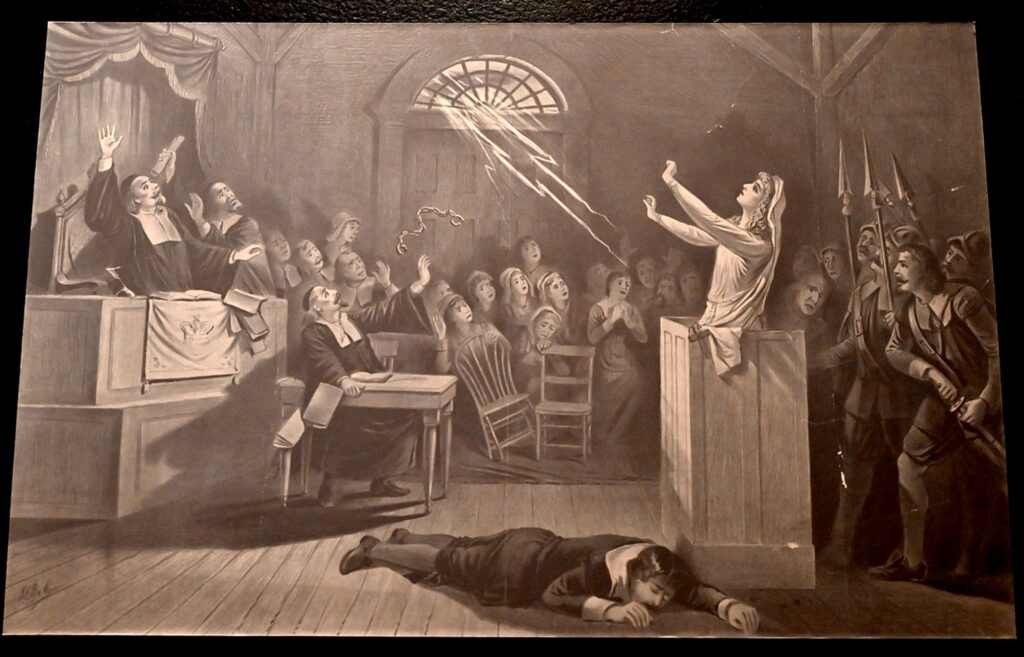
There is also a tape loom belonging to Rebecca Putnam, decorated with both Christian and folk symbols. The Putnams were an influential and prominent landowning family that actively accused and testified against neighbors during the trials, including the three Towne Sisters (we see the window of the Towne home). Her cousin Ann Putnam Jr. was a principal accuser and one of the first girls to experience afflictions, and other relatives accused dozens of victims. Her uncle, Thomas Putnam Jr., served as a secretary for the trials while her father, John Putnam Jr., was a constable.

There is a cane owned by Philip English, a wealthy man of high social status, who was nonetheless (or because of that) accused of witchcraft; along with an item belonging to a farmer.
And then there are the original documents. The transcript for Elizabeth How – Alexander McQueen’s ancestor – is most complete, from the accusation to the trial to the order of payment of restitution in 1712 to Elizabeth’s How’s daughters, Mary and Abigail, after her exoneration 20 years after her execution.
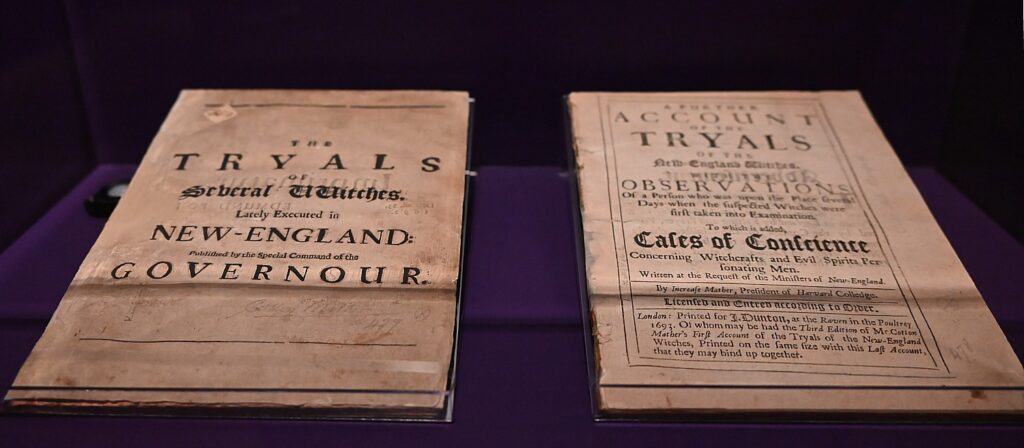
We see a copy of one of the first histories of Salem Witch Trials, produced by none other than father and son clergymen, Increase and Cotton Mather. “Salem’s legal proceedings came to an abrupt halt in October 1692 as the mounting death toll alongside widespread chaos provoked a prevailing sense that the trials had gone too far,” the notes say. “The colony was in crisis – threatening the political authority of the Puritans. Father and son clergymen, Increase and Cotton Mather, were allies of the Massachusetts Bay colony’s new governor, Sir William Phips. A year after the trial, they provided contemporary justifications of the controversial trials, instructing their religious flocks on how to interpret the story and providing political cover, while acknowledging faults in the legal system. They attacked witches as the embodiment of evil, and defended the court’s verdicts and executions, but expressed discomfort with the court’s admission of spectral evidence. Only verifiable evidence or witnesses, Cotton Mather argued, should ‘turn the scale’ of justice in court going forward.”
(Notably, the Puritans who established Plymouth and dominated Massachusetts Colony, are extinct.)
In 1693, the Reverend Francis Dane Sr. wrote an apology, disturbed by how easily the community turned against one another. “One of the few courageous voices of resistance, the long-time Andover resident had been named as a possible witch, along with 28 of his family members-including Alexander McQueen’s ancestor, Elizabeth How, and Elizabeth ‘Betty’ Johnson Jr.” In a statement, Dane expresses regret that the community was not more tolerant, more charitable and more forgiving “hence we so easily parted with our neighbors of honest & good report, and members in full Communion, hence we so easily parted with our Children…hence such strange breaches in families.”
Considering that the population of Salem and Salem Village was about 2000 in 1692, that would mean that 10 percent of the community was ensnared and prosecuted for witch craft, with 19 put to death.
Beginning in 1696, trial victims and family members petitioned the General Court to clear the records of those falsely accused – in order to get their property back, since descendents of a witch could not inherit the property. Many of the relatives fled to other communities to start life over.
In 1711, the Province issued a reversal nullifying all convictions, judgments and attainders against those on the list, but six of those executed were not on the list, presumably because no petitioners applied. Elizabeth Johnson Jr.’s name was only cleared in July 2022.
The irony is that there were no witches in Salem in 1692, but today, you can visit Salem and find a wicca community.
And as I go through the exhibit, it appears to me that the impetus for the Salem witch hunts was different than that of Europe’s. In Europe, the motivation seemed to have been more clearly a desire for male religious leaders to retain their absolute control against “uppity” women who were healers and midwives and might challenge their divine authority. In Salem, it seems to have been spurred on more because of personal vendettas and outright opportunistic property theft. This may be a distinction without a difference.
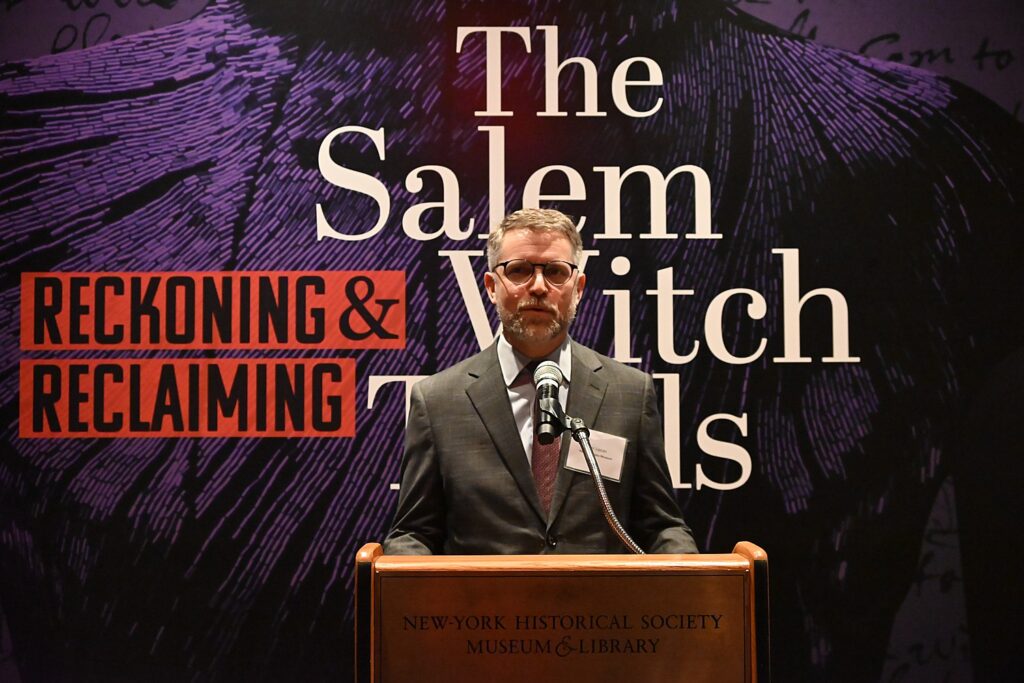
“The Salem witch trials have become rhetorical shorthand in contemporary discourse, but the actual historical events are frequently overlooked,” said Dan Lipcan, PEM’s Ann C. Pingree Director of the Phillips Library, along with Curator Paula Richter and Associate Curator Lydia Gordon. “When we conceived of this exhibition, we set out to provide a framework for a modern-day audience to reckon with what this chapter of history meant for the development of this country, and what it says about the potential within each of us. We want visitors to feel the continuing impact of the Salem witch trials, to consider what it says about race and gender, and to think about how they themselves might react to similar moments of widespread injustice.”
Coming into the exhibit, I had the idea that the Salem Witch Trials factored into Thomas Jefferson’s call for Separation of Church and State, as well as the judicial due process that was embedded into the Constitution and Bill of Rights.
But what was remarkable to me is to realize that the Salem Witch Trials apparently were not widely known through the rest of the colonies. This is before there would have been newspapers that were linked together by Ben Franklin (I believe the first actual syndicated columnist). The trials only lasted a year and were followed by community-wide shame over what occurred – both for the relatives of those accused, many of whom left Salem and by the accusers who realized they had gone too far.
Other places that had witch trials (Long Island and in Virginia) but these were more likely triggered by events in Europe than by what went on in Salem.
The Founders were more likely inspired to institute Separation of Church and State and judicial due process – 80 years later – by the Enlightenment which looked to science, reason and humanism, in place of the supernatural, Lipcan suggested to me.
So how did the Salem Witch Trials become so prominent in the American psyche?
I suspect it had a lot to do with American novelist Nathaniel Hawthorne and the publication of “The House of Seven Gables” in 1851, a follow-up to his hit, anti-Puritan “The Scarlet Letter” novel in 1850. (Hawthorne was so ashamed of his great-great-grandfather John Hathorne, one of the judges who oversaw the Salem witch trials that added the “w” to his surname when he was in his early twenties.) I suggest Hawthorne resurrected the Salem Witch Trials and brought widespread awareness, igniting imagination and intrigue.
Hawthorne’s friend, the poet Henry Wadsworth Longfellow, did his part to create the myths surrounding the Salem Witch Trials, depicting Tituba as an African (“Obi”) practitioner of magic, though there is no evidence she was either Black or a witch, aside from the confession she gave under duress and later retracted.

The exhibit has a copy of a poem by Emily Dickinson (1830-1886) written in her own hand, “Witchcraft was/ hung, in History, / but History / and I /Find all the / Witchcraft that /we need /Around us,/every Day—“
Also in the mid-1800s, a new train from Boston brought visitors to Salem who were taken around to sights by street car. Then around the bicentennial, 1892, the witch trials became commercialized – an industry of witch and related ephemera like buttons, even a souvenir witch spoon, developed, Paula Richter of the Peabody Essex Museum tells me.
The Salem Witch Trials became the center of a massive tourism economy that emerged in the 1950s, growing steadily until today. An annual event, Salem’s Haunted Happenings, has become so popular, it has expanded from Halloween weekend, to October weekends, to all October, with a score of perennial attractions that include the House of Seven Gables; Cry Innocent: The People vs. Bridget Bishop, recreating a trial based on actual transcripts; The Witch House, home of Judge Jonathan Corwin ( the only structure still standing in Salem with direct ties to the Witchcraft Trials of 1692; and Witch Dungeon Museum. It was not until 1992, the tercentenary of the Salem Witch Trials, that the Salem Witch Trials Memorial was dedicated – by Nobel Laureate and Holocaust survivor Elie Wiesel.
“Many people are introduced to the Salem Witch Trials through popular film and television. Fictionalized versions of the story and its legacy continue to captivate audiences to this day. Yet these depictions often rely on stereotypes that ignore the complex social and gendered circumstances that led to the events of 1692.”
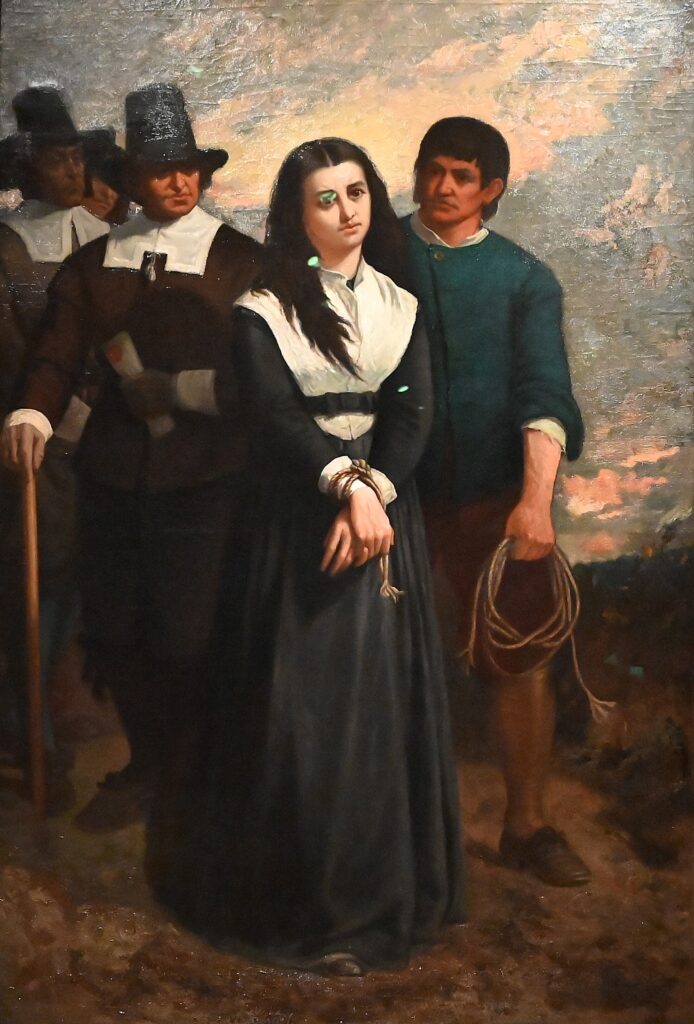
We see one of these in a life-size painting that dates from 1869 of “The Salem Martyr” – the woman who posed as a condemned witch was a descendent of one of the hanged victims.
Arthur Miller used the Salem Witch Trials as his metaphor for McCarthy’s “House on Unamerican Committee’s” witch hunts for Communists in Hollywood and government. (See “Why I Wrote “The Crucible”, New Yorker Magazine)
The exhibition also features two reclamation projects by contemporary artists who are descendants of the accused, including a dress and accompanying photographs from fashion designer Alexander McQueen’s fall/winter 2007 collection, “In Memory of Elizabeth How, 1692.” In creating this collection, which was based on research into the designer’s ancestor—one of the first women to be condemned and hanged as a witch—McQueen mined historical symbols of witchcraft, paganism, religious persecution, and magic. Documents show how Elizabeth How was accused and ultimately condemned in July 1692, adding to the gravity of the designer’s show.
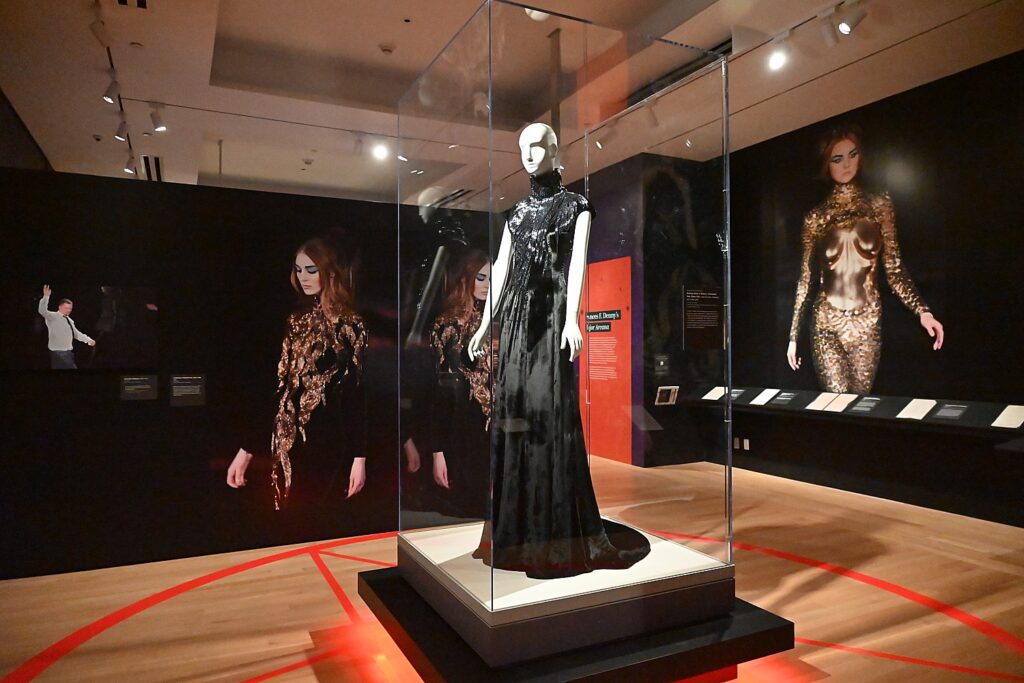
The exhibit features one of the dresses – a stunning and dramatic black velvet that shimmers with light –along with photos from the runway show and a painted red pentagram just as in the Paris show – juxtaposed with copies of the original transcripts from the trial.
Photographer Frances F. Denny went on a three-year odyssey to document people who today identify as witches. Thirteen from her series, “Major Arcana: Portraits of Witches in America” challenge the traditional notion of witchery by celebrating the spectrum of identities and spiritual practices of people who identify as witches today. Complementing the photographers are audio recordings so you can listen to their voices.
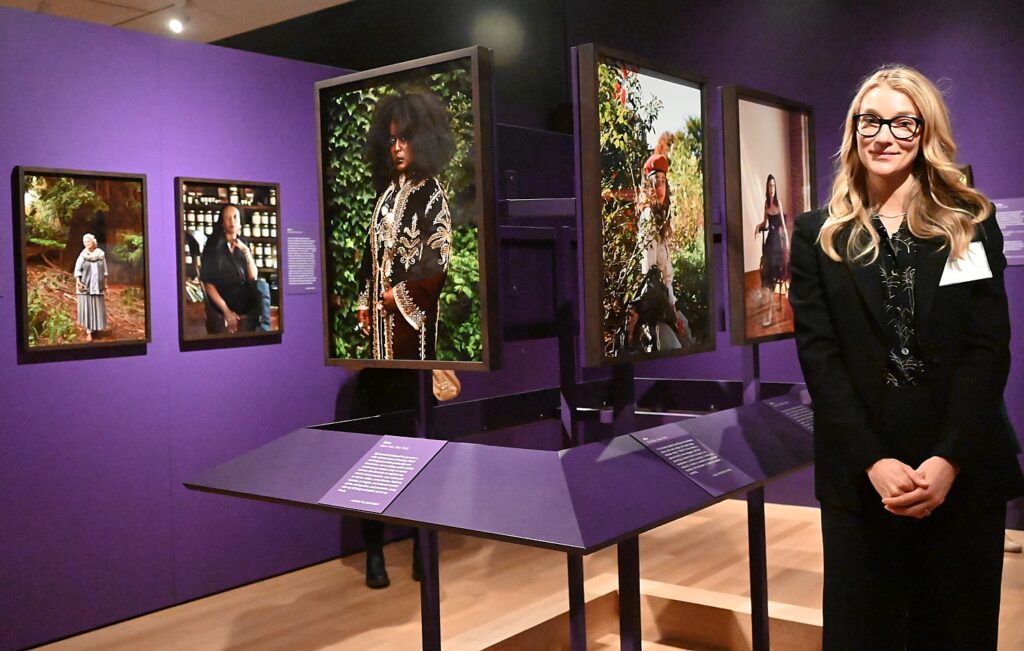
There is also an immersive experience based on New-York Historical’s collection of tarot cards that prompts viewers to imagine what reclaiming witchcraft might mean.
The exhibition concludes with a display that connects the Salem witch trials to modern life and a warning and a challenge of sorts: what would you do when such profound injustice arises?
“The Salem Witch Trials: Reckoning and Reclaiming” is organized by the Peabody Essex Museum (PEM) in Salem, Massachusetts. It was co-curated by Dan Lipcan, the Ann c. Pingree Director of the Phillips library; Paula Richter, Curator; and Lydia Gordon, Associate Curator. At New-York Historical, it was coordinated by Anna Danziger Halperin, Mellon Foundation postdoctoral fellow in women’s history and public history, Center for women’s History.
There is also various programming related to the exhibit, and a special exhibition guide for families.
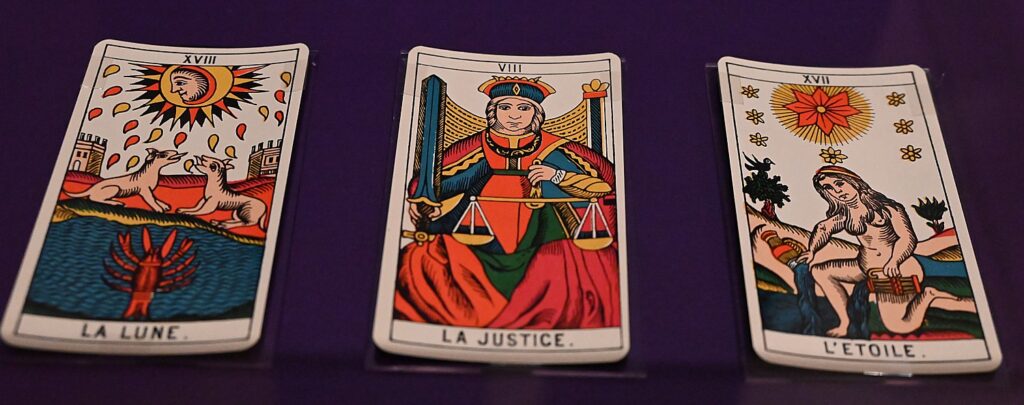
There’s so much to see and enjoy at the New-York Historical Society, a destination for history since 1804 and New York’s first museum. There is a world-class permanent exhibit of Tiffany; a relatively new (and fascinating exhibit) about journalist and historian Robert Caro’s process (looking at his notebooks and manuscripts is amazing); two sensational films, “We Rise” about the women’s movement, and “New York City”, plus changing exhibits. (There is also a lovely café.)
The Museum and the Patricia D. Klingenstein Library convey the stories of the city and nation’s diverse populations, expanding our understanding of who we are as Americans and how we came to be. Ever-rising to the challenge of bringing little or unknown histories to light, New-York Historical will soon inaugurate a new annex housing its Academy for American Democracy as well as the American LGBTQ+ Museum. These latest efforts to help forge the future by documenting the past join New-York Historical’s DiMenna Children’s History Museum and Center for Women’s History. Digital exhibitions, apps, and its For the Ages podcast make it possible for visitors everywhere to dive more deeply into history.
The New-York Historical Society is located at 170 Central Park West at Richard Gilder Way (77th Street), New York, NY 10024, 212-873-3400, nyhistory.org. Connect at @nyhistory on Facebook, Twitter, Instagram, YouTube, and Tumblr.
__________________
© 2022 Travel Features Syndicate, a division of Workstyles, Inc. All rights reserved. Visit goingplacesfarandnear.com, www.huffingtonpost.com/author/karen-rubin, and travelwritersmagazine.com/TravelFeaturesSyndicate/. Blogging at goingplacesnearandfar.wordpress.com and moralcompasstravel.info. Visit instagram.com/going_places_far_and_near and instagram.com/bigbackpacktraveler/ Send comments or questions to FamTravLtr@aol.com. Tweet @TravelFeatures. ‘Like’ us at facebook.com/NewsPhotoFeatures
